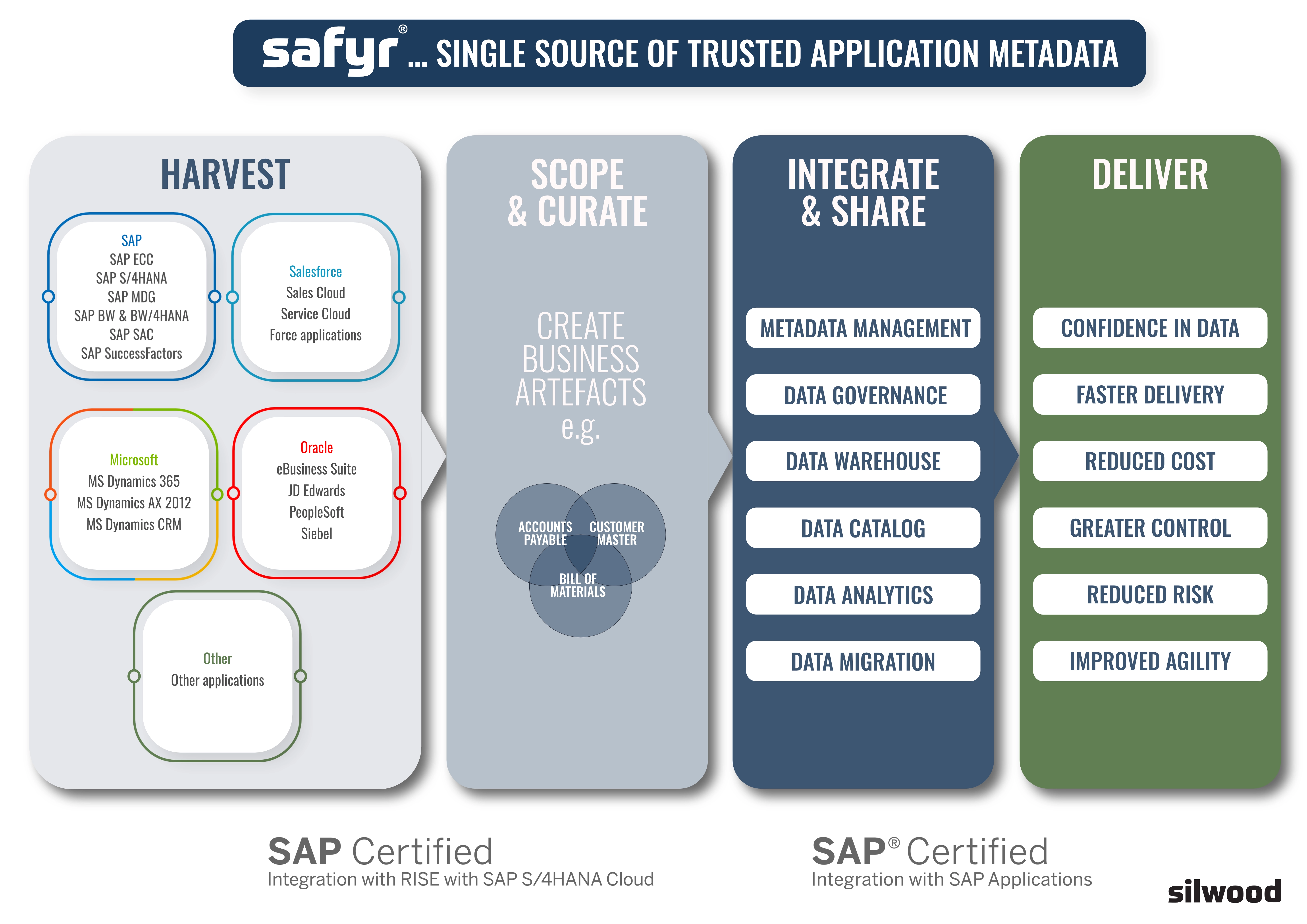The (Business) Case for Safyr

When would it be the right time to consider a fresh approach to the way you access and work with your ERP application metadata?
For those of you who are faced with the daunting task of understanding the data models which underpin ERP/CRM systems from SAP, Oracle, Salesforce and other vendors, you may already appreciate the scale and nature of the challenge that confronts you.
Most ERP’s have one or more of the following characteristics which means that accessing, analyzing, curating and exploring their metadata can delay delivery, reduce trust in data, and impede agility in any data intensive project.
- Difficult to access business, or descriptive, metadata
- Relationship data not readily available
- Large complex data model
- Extensive customization
- Multiple instances of the application
- No metadata discovery and analysis tools for data engineers
- No simple method for sharing metadata with other software products or data governance platforms
Traditional approaches
These include asking internal technical or application specialists to provide selected metadata for the appropriate business use cases or employing external consultants to perform this task or build a metadata glossary.
Other methods include searching the internet for relevant data models, manually scouring through documentation and even guesswork.
Even when the relevant metadata has been found and verified, it is common for it to be manually keyed into other products, or for organisations to spend time developing integrations to achieve this.
The drawbacks associated with these methods often mean that the delivery of the benefits from a particular project are delayed, costs overrun and most importantly the confidence in your data can be compromised.
If you want to give your project a better chance of success then perhaps it is time to consider an alternative. And, if you are looking at Safyr what is the business case for investing in a different approach.
Safyr
Safyr is the only piece of software which allows you to be sure that you can quickly and easily locate and find any table and its related tables and make use of that information in your data, application or enterprise related project. Whilst Safyr is priced to allow for rapid return, it is often important to be able to justify the need for, and investment in such a product as it is not normally added to the list of tools required at the beginning of an implementation, Data Integration, Master Data Management, ETL, Enterprise Architecture or Governance initiative.
Consider the potential time and cost saving of an automated and intuitive tool over traditional methods
- Compare how long it takes and at what cost to find the required tables and their related tables when relying on manual methods and internal or external specialists with the speed with which any tables and their related information can be found using Safyr by people who do not need a detailed level of knowledge of the application.
- It is difficult to predict average search times with Safyr, however they are typically measured in minutes.
- Accuracy can also be an issue. It is possible that the specialist or manual method might not provide the right answer immediately which means it will be necessary to go through the process again which may add a delay and additional cost to that project stage.
- With Safyr the rapid process of scoping means that if the wrong tables are identified then all the user has to do is to retrace their steps or start over all which takes a very short space of time compared with a manual process. Safyr will also be 100% accurate because it takes its information from the application as implemented.
- Sometimes it is necessary to be able to identify the tables associated with a particular transaction. Compare the time and possible cost involved in searching for tables associated with a transaction manually, especially if customisations have been made with the time it takes to perform this search using Safyr’s specialist application hierarchy search facility.
- Documenting data models for SAP, Oracle, Salesforce and Enterprise systems from other vendors is often necessary to meet a broad range of Data Governance, Auditing and internal compliance requirements.Consider the time and cost associated for example with documenting an entire SAP data model using a combination of manual methods and spreadsheets with the cost of Safyr which means that the entire data model is automatically documented. In fact with over 90000 base tables (before customisations) plus their relationships and a million plus nodes in the application hierarchy in SAP for example we suggest that this is totally impractical to do manually and to keep up to date following changes.
- Safyr can be used to keep up to date with changes very quickly, retain previous data models and is 100% accurate. Safyr can also restrict the resulting data models and documentation to only those tables which actually contain data, thereby reducing complexity and avoiding unnecessary analysis.
General advantages and benefits
- Safyr provides a sharable and reusable resource which can be made available to other teams and for other projects without needing to engage external resource or disrupt technical application specialists.
- Safyr can help to ensure that the corporate information architecture is understood in the context of detailed data and data models and assist in enabling communication between the business and IT functions.
- Safyr allows data stewards and other staff who work with the movement, understanding and integration of data to have a clear view on the data models which are otherwise obscured by their inherent complexity. Safyr allows the Enterprise systems to be fully documented in terms of data models, which complements the documentation provided by the vendor and Systems Integrator in respect of processes, transactions and applications.
